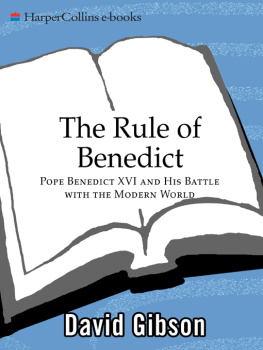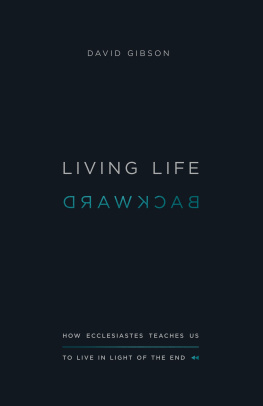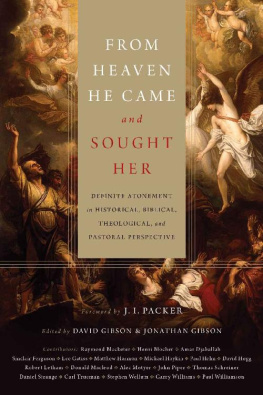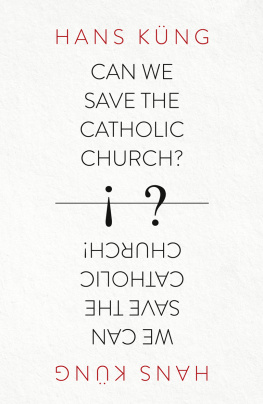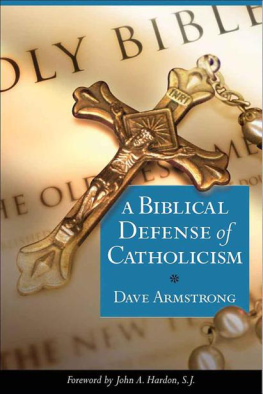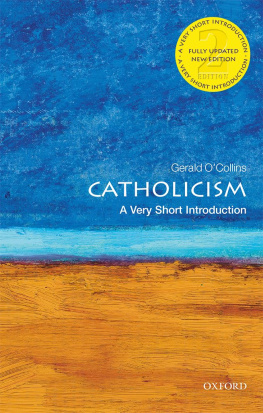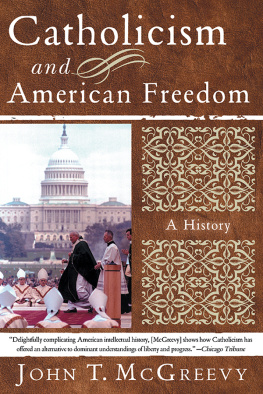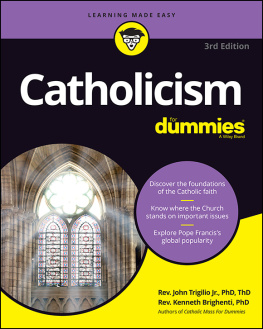David Gibson - The Coming Catholic Church: How the Faithful Are Shaping a New American Catholicism
Here you can read online David Gibson - The Coming Catholic Church: How the Faithful Are Shaping a New American Catholicism full text of the book (entire story) in english for free. Download pdf and epub, get meaning, cover and reviews about this ebook. year: 2011, publisher: HarperCollins, genre: Detective and thriller. Description of the work, (preface) as well as reviews are available. Best literature library LitArk.com created for fans of good reading and offers a wide selection of genres:
Romance novel
Science fiction
Adventure
Detective
Science
History
Home and family
Prose
Art
Politics
Computer
Non-fiction
Religion
Business
Children
Humor
Choose a favorite category and find really read worthwhile books. Enjoy immersion in the world of imagination, feel the emotions of the characters or learn something new for yourself, make an fascinating discovery.
- Book:The Coming Catholic Church: How the Faithful Are Shaping a New American Catholicism
- Author:
- Publisher:HarperCollins
- Genre:
- Year:2011
- Rating:4 / 5
- Favourites:Add to favourites
- Your mark:
- 80
- 1
- 2
- 3
- 4
- 5
The Coming Catholic Church: How the Faithful Are Shaping a New American Catholicism: summary, description and annotation
We offer to read an annotation, description, summary or preface (depends on what the author of the book "The Coming Catholic Church: How the Faithful Are Shaping a New American Catholicism" wrote himself). If you haven't found the necessary information about the book — write in the comments, we will try to find it.
Rather than chronicling the well-reported sexual abuse scandal or advocating a particular reform agenda, David Gibson shows how the crisis in the church is unleashing forces that will change American Catholicism forever.
The Coming Catholic Church: How the Faithful Are Shaping a New American Catholicism — read online for free the complete book (whole text) full work
Below is the text of the book, divided by pages. System saving the place of the last page read, allows you to conveniently read the book "The Coming Catholic Church: How the Faithful Are Shaping a New American Catholicism" online for free, without having to search again every time where you left off. Put a bookmark, and you can go to the page where you finished reading at any time.
Font size:
Interval:
Bookmark:
The Coming Catholic Church
How the Faithful
Are Shaping a
New American Catholicism
David Gibson

This book is dedicated to the children who survived sexual abuse, and to the memory of those who did not.
Contents
Preface
The Current Catholic Church
I n the year since this book was published, so much has changed in the Catholic Church and yet so much remains the same.
In July 2003 the Archdiocese of Boston, the epicenter of the sexual abuse scandal that led to the wider crisis in the churchand this book gained a new leader in the person of a Capuchin friar, Sean Patrick OMalley. Although as orthodox as the man he replaced, Cardinal Bernard Law, no one could be more different in style and temperament from Law than OMalley, and no appointment could have sent a more encouraging signal to the faithful.
I ask you, and plead with you: Repair my church, OMalley said at his introductory press conference, his words and his trademark brown robe and sandals evoking his spiritual forebear, St. Francis of Assisi. Immediately afterward OMalley met with victims of sexual abuse and promised to work for a quick settlement for the hundreds of outstanding claims: We must step up to the plate. Peoples lives are more important than money.
OMalley made good on his pledge, replacing Laws legal team with his own lawyer. Within weeks they reached a comprehensive, $85 million settlement that Law had said the church could not afford. OMalley moved into a small apartment behind the cathedral and put up for sale the opulent mansion that had been the homeand symbol of power for Boston prelates since the 1920s.
More drama was to come. Just a few weeks after OMalleys installation, John Geoghan, the former priest whose serial predations were the fuse that lit the scandal bomb, was beaten to death in prison by a convicted murderer who claimed to have been molested as a child. And in November 2003, in an Ohio courtroom, Cincinnati Archbishop Daniel E. Pilarczyk personally entered a no-contest plea on behalf the archdiocese for failing to report sexually abusive priests. While the crimes took place years before Pilarczyks tenure, it was the first time that a diocese had been convicted of criminal charges related to clergy abuse.
Then, in January 2004, on the Feast of the Epiphany, two years to the day after the Boston Globe ran its first story on Geoghan, the U.S. bishops newly constituted Office of Child and Youth Protection released a report card on how the nations dioceses were complying with the abuse-prevention policies the bishops had passed in Dallas in 2002. The audit found that more than 90 percent of the dioceses were complying, and the rest were on their way, with a regular schedule of monitoring in place to improve all of the dioceses performance. The office operates under the aegis of the National Review Board, a panel of 12 prominent lay Catholics, and is headed by a former top-ranking FBI agent. The office sent 54 auditors, most of them former federal investigators, to conduct on-site surveys in the nations 194 dioceses.
The audit was unprecedented in its scope and in its nature: lay Catholics investigating their own bishops.
Even more eye-opening, however, was the pair of reports released by the Review Board a few weeks later, at the end of February, two days after Ash Wednesday.
The first report was a quantitative survey conducted by independent researchers at the John Jay College of Criminal Justice in New York. The report showed that more than 4,000 priests, or just over 4 percent, had abused more than 10,000 children in the previous 50 years in the United States. The report also showed that American dioceses paid out nearly $600 million in compensation and related costs during that period, a partial figure that was expected to top three-quarters of a billion dollars when large settlements such as Bostons were included.
For the first time in the 20 years since the initial wave of clergy abuse scandals broke, American Catholicsand their bishopshad a reasonably accurate reckoning of the true size of the abuse problem. And it was produced by a team of lay Catholics and outside researchers who would never before have been granted such access and influence over the hierarchy.
But the second report, on contexts and causes, was the kicker: a 140-page dissection by the lay board of the scandal and the hierarchys failings.
With unexpected candor, but without the rancor of most critiques, the board pointed to the bishops shortcomings, saying their responses to the abuse cases were too often characterized by moral laxity, excessive leniency, insensitivity, secrecy, and neglect, and attributed their reaction in part to their attitude that priests and bishops are apart from and superior to the laity.
The board pointedly noted that the crisis was not a failure of doctrine, but of leadership, and they challenged the bishops to be more open in their dealings on all levels. The review board called for more input on the selection of bishops, performance reviews for the hierarchy, and greater use of structures such as diocesan pastoral councils, which have often been dismissed by bishops.
This is where things stand now: Strong sexual abuse policies are in place, with a promise of regular oversight. And that means the church is moving on to the larger issues that were always at the heart of the crisis.
That the context and causes report overshadowed the quantitative John Jay study was not surprising. Catholics were prepared for the worst regarding clergy abuse. What they really wanted to know is how the scandal came about, why their leaders were not being held accountable, and what they could do about it, apart from praying for a miracle. Lay anger at the bishopsand the anger of many priests toward the hierarchycontinued to focus on the actions and attitude of the hierarchy, and that in turn pointed to the wider dysfunction plaguing modern-day Catholicism.
In fact, rather than marking an end to the crisis, the developments of the past year have only underscored the enduring centrality of the broader issues that The Coming Catholic Church explores. The crisis is not just about sexual abuse, nor is it only about bishops, priests, or the laity. It is about the interactionor lack thereofof all three, and the need to find ways to change that dynamic.
The follow-up to Archbishop OMalleys appointment was a case in point. While OMalleys promotion occasioned hope and hyperbole Hes the messiah, declared Boston Mayor Thomas M. Meninothe archbishop still faced long-term challenges that would not yield to quick fixes. The fall 2003 church census, for example, showed that just 15 percent of the 2 million Catholics in the Boston archdiocese were attending Mass weekly, and in early 2004 OMalley announced a plan for parish closings that reflected the realities of financial shortfalls and a worsening shortage of priests.
In Boston and elsewhere, lay Catholics who did stay demanded a greater voice in church life. Accountability and transparency, governance and collaboration, remained the dominant themes, and not just on matters of sexual abuse. The scandal revealed gaping holes in the churchs financial safety net, with little information available about how and where the nearly $6 billion that American Catholics donateand continue to donateto their church each year is being spent. The absence or under-performance of parish and diocesan councils led to calls for their renewal. And lay reform groups such as Voice of the Faithful continued to seek a direct role in church affairs even as they tried to figure out exactly how such a novel idea could work in real life.
For priests, the new data showing that the vast majority of them have been faithful to their calling could not overcome the anguish of the previous two years. Nor could it halt the trend lines that continue to alter the landscape of parish lifethe steady decline in vocations to the priesthood and the exploding growth in lay ministry. Although the National Review Board argued that celibacy and the growing number of gay men in the priesthood did not cause the scandal, they called for closer scrutiny of both issues.
Next pageFont size:
Interval:
Bookmark:
Similar books «The Coming Catholic Church: How the Faithful Are Shaping a New American Catholicism»
Look at similar books to The Coming Catholic Church: How the Faithful Are Shaping a New American Catholicism. We have selected literature similar in name and meaning in the hope of providing readers with more options to find new, interesting, not yet read works.
Discussion, reviews of the book The Coming Catholic Church: How the Faithful Are Shaping a New American Catholicism and just readers' own opinions. Leave your comments, write what you think about the work, its meaning or the main characters. Specify what exactly you liked and what you didn't like, and why you think so.


